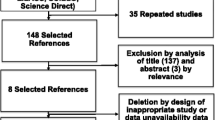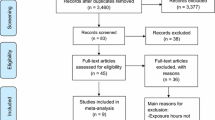Abstract
Background
The incidence of soccer (football) injuries is among the highest in sports. Despite this high rate, insufficient evidence is available on the efficacy of preventive training programmes on injury incidence.
Objective
To systematically study the evidence on preventive exercise-based training programmes to reduce the incidence of injuries in soccer.
Data sources
The databases EMBASE/MEDLINE, PubMed, CINAHL, Cochrane Central Register of controlled trials, PEDro and SPORTDiscus™ were searched for relevant articles, from inception until 20 December 2011. The methodological quality of the included studies was assessed using the PEDro scale.
Study selection
The inclusion criteria for this review were (1) randomized controlled trials or controlled clinical trials; (2) primary outcome of the study is the number of soccer injuries and/or injury incidence; (3) intervention focusing on a preventive training programme, including a set of exercises aimed at improving strength, coordination, flexibility or agility; and (4) study sample of soccer players (no restrictions as to level of play, age or sex). The exclusion criteria were: (1) the article was not available as full text; (2) the article was not published in English, German or Dutch; and (3) the trial and/or training programme relates only to specific injuries and/or specific joints. To compare the effects of the different interventions, we calculated the incidence risk ratio (IRR) for each study.
Results
Six studies involving a total of 6,099 participants met the inclusion criteria. The results of the included studies were contradictory. Two of the six studies (one of high and one of moderate quality) reported a statistical significant reduction in terms of their primary outcome, i.e. injuries overall. Four of the six studies described an overall preventive effect (IRR<1), although the effect of one study was not statistically significant. The three studies that described a significant preventive effect were of high, moderate and low quality.
Conclusions
Conflicting evidence has been found for the effectiveness of exercise-based programmes to prevent soccer injuries. Some reasons for the contradictory findings could be different study samples (in terms of sex and soccer type) in the included studies, differences between the intervention programmes implemented (in terms of content, training frequency and duration) and compliance with the programme. High-quality studies investigating the best type and intensity of exercises in a generic training programme are needed to reduce the incidence of injuries in soccer effectively.

Similar content being viewed by others
Reference
FIFA big count 2006. Zurich: FIFA, 2007.
Krustrup P, Aagaard P, Nybo L, et al. Recreational football as a health promoting activity: a topical review. Scand J Med Sci Sports. 2010;20(Suppl 1):1–13.
Hoff J, Helgerud J. Endurance and strength training for soccer players: physiological considerations. Sports Med. 2004;34(3):165–80.
Reilly T, Gilbourne D. Science and football: a review of applied research in the football codes. J Sports Sci. 2003;21(9):693–705.
Schmikli SL, Backx FJ, Kemler HJ, et al. National survey on sports injuries in The Netherlands: target populations for sports injury prevention programs. Clin J Sport Med. 2009;19(2):101–6.
Ekstrand J, Hagglund M, Walden M. Injury incidence and injury patterns in professional football: the UEFA injury study. Br J Sports Med. 2011;45(7):553–8.
Inklaar H. Soccer injuries. I: incidence and severity. Sports Med. 1994;18(1):55–73.
Mickel TJ, Bottoni CR, Tsuji G, et al. Prophylactic bracing versus taping for the prevention of ankle sprains in high school athletes: a prospective, randomized trial. J Foot Ankle Surg. 2006;45(6):360–5.
Mohammadi F. Comparison of 3 preventive methods to reduce the recurrence of ankle inversion sprains in male soccer players. Am J Sports Med. 2007;35(6):922–6.
Waldén M, Atroshi I, Magnusson H, et al. Prevention of acute knee injuries in adolescent female football players: cluster randomised controlled trial. BMJ. 2012;344:e3042.
Junge A, Dvorak J. Soccer injuries: a review on incidence and prevention. Sports Med. 2004;34(13):929–38.
Dvorak J, Junge A, Chomiak J, et al. Risk factor analysis for injuries in football players. Possibilities for a prevention program. Am J Sports Med. 2000;28(5 Suppl):S69–74.
Bir CA, Cassatta SJ, Janda DH. An analysis and comparison of soccer shin guards. Clin J Sport Med. 1995;5(2):95–9.
Hawkins RD, Fuller CW. A prospective epidemiological study of injuries in four English professional football clubs. Br J Sports Med. 1999;33(3):196–203.
Ekstrand J, Gillquist J. The avoidability of soccer injuries. Int J Sports Med. 1983;4(2):124–8.
Ekstrand J, Gillquist J, Liljedahl SO. Prevention of soccer injuries. Supervision by doctor and physiotherapist. Am J Sports Med. 1983;11(3):116–20.
Arnason A, Andersen TE, Holme I, et al. Prevention of hamstring strains in elite soccer: an intervention study. Scand J Med Sci Sports. 2008;18(1):40–8.
Askling C, Karlsson J, Thorstensson A. Hamstring injury occurrence in elite soccer players after preseason strength training with eccentric overload. Scand J Med Sci Sports. 2003;13(4):244–50.
Petersen J, Thorborg K, Nielsen MB, et al. Preventive effect of eccentric training on acute hamstring injuries in men’s soccer: a cluster-randomized controlled trial. Am J Sports Med. 2011;39(11):2296–303.
Alentorn-Geli E, Myer GD, Silvers HJ, et al. Prevention of non-contact anterior cruciate ligament injuries in soccer players. Part 2: a review of prevention programs aimed to modify risk factors and to reduce injury rates. Knee Surg Sports Traumatol Arthrosc. 2009;17(8):859–79.
Grindstaff TL, Hammill RR, Tuzson AE, et al. Neuromuscular control training programs and noncontact anterior cruciate ligament injury rates in female athletes: a numbers-needed-to-treat analysis. J Athl Train. 2006;41(4):450–6.
Kiani A, Hellquist E, Ahlqvist K, et al. Prevention of soccer-related knee injuries in teenaged girls. Arch Intern Med. 2010;170(1):43–9.
Mandelbaum BR, Silvers HJ, Watanabe DS, et al. Effectiveness of a neuromuscular and proprioceptive training program in preventing anterior cruciate ligament injuries in female athletes: 2-year follow-up. Am J Sports Med. 2005;33(7):1003–10.
Sherrington C, Herbert RD, Maher CG, et al. PEDro. A database of randomized trials and systematic reviews in physiotherapy. Man Ther. 2000;5(4):223–6.
Maher CG, Sherrington C, Herbert RD, et al. Reliability of the PEDro scale for rating quality of randomized controlled trials. Phys Ther. 2003;83(8):713–21.
Lievense AM, Bierma-Zeinstra SM, Verhagen AP, et al. Influence of obesity on the development of osteoarthritis of the hip: a systematic review. Rheumatology (Oxford). 2002;41(10):1155–62.
Van Peppen RP, Kwakkel G, Wood-Dauphinee S, et al. The impact of physical therapy on functional outcomes after stroke: what’s the evidence? Clin Rehabil. 2004;18(8):833–62.
Emery CA, Meeuwisse WH. The effectiveness of a neuromuscular prevention strategy to reduce injuries in youth soccer: a cluster-randomised controlled trial. Br J Sports Med. 2010;44(8):555–62.
Heidt RS Jr, Sweeterman LM, Carlonas RL, et al. Avoidance of soccer injuries with preseason conditioning. Am J Sports Med. 2000;28(5):659–62.
Junge A, Rosch D, Peterson L, et al. Prevention of soccer injuries: a prospective intervention study in youth amateur players. Am J Sports Med. 2002;30(5):652–9.
Soligard T, Myklebust G, Steffen K, et al. Comprehensive warm-up programme to prevent injuries in young female footballers: cluster randomised controlled trial. BMJ. 2008;337:a2469.
Söderman K, Werner S, Pietila T, et al. Balance board training: prevention of traumatic injuries of the lower extremities in female soccer players? A prospective randomized intervention study. Knee Surg Sports Traumatol Arthrosc. 2000;8(6):356–63.
Steffen K, Myklebust G, Olsen OE, et al. Preventing injuries in female youth football: a cluster-randomized controlled trial. Scand J Med Sci Sports. 2008;18(5):605–14.
Fuller CW, Ekstrand J, Junge A, et al. Consensus statement on injury definitions and data collection procedures in studies of football (soccer) injuries. Clin J Sport Med. 2006;16(2):97–106.
Benjaminse A, Gokeler A, Fleisig GS, et al. What is the true evidence for gender-related differences during plant and cut maneuvers? A systematic review. Knee Surg Sports Traumatol Arthrosc. 2011;19(1):42–54.
Vescovi JD, VanHeest JL. Effects of an anterior cruciate ligament injury prevention program on performance in adolescent female soccer players. Scand J Med Sci Sports. 2010;20(3):394–402.
Waldén M, Hagglund M, Werner J, et al. The epidemiology of anterior cruciate ligament injury in football (soccer): a review of the literature from a gender-related perspective. Knee Surg Sports Traumatol Arthrosc. 2011;19(1):3–10.
Sadoghi P, von Keudell A, Vavken P. Effectiveness of anterior cruciate ligament injury prevention training programs. J Bone Joint Surg Am. 2012;94(9):769–76.
Soligard T, Nilstad A, Steffen K, et al. Compliance with a comprehensive warm-up programme to prevent injuries in youth football. Br J Sports Med. 2010;44(11):787–93.
Finch C. A new framework for research leading to sports injury prevention. J Sci Med Sport. 2006;9(1–2):3–9.
Verhagen EA, Van Stralen MM, Van Mechelen W. Behaviour, the key factor for sports injury prevention. Sports Med. 2010;40(11):899–906.
Caraffa A, Cerulli G, Projetti M, et al. Prevention of anterior cruciate ligament injuries in soccer: a prospective controlled study of proprioceptive training. Knee Surg Sports Traumatol Arthrosc. 1996;4(1):19–21.
Gilchrist J, Mandelbaum BR, Melancon H, et al. A randomized controlled trial to prevent noncontact anterior cruciate ligament injury in female collegiate soccer players. Am J Sports Med. 2008;36(8):1476–83.
Hewett TE, Lindenfeld TN, Riccobene JV, et al. The effect of neuromuscular training on the incidence of knee injury in female athletes: a prospective study. Am J Sports Med. 1999;27(6):699–706.
Engebretsen AH, Myklebust G, Holme I, et al. Prevention of injuries among male soccer players: a prospective, randomized intervention study targeting players with previous injuries or reduced function. Am J Sports Med. 2008;36(6):1052–60.
Pfeiffer RP, Shea KG, Roberts D, et al. Lack of effect of a knee ligament injury prevention program on the incidence of noncontact anterior cruciate ligament injury. J Bone Joint Surg Am. 2006;88(8):1769–74.
Dvorak J, Junge A, Derman W, et al. Injuries and illnesses of football players during the 2010 FIFA World Cup. Br J Sports Med. 2011;45(8):626–30.
Hoff GL, Martin TA. Outdoor and indoor soccer: injuries among youth players. Am J Sports Med. 1986;14(3):231–3.
Emery CA, Meeuwisse WH. Risk factors for injury in indoor compared with outdoor adolescent soccer. Am J Sports Med. 2006;34(10):1636–42.
Acknowledgments
No sources of funding were used for the preparation of this review. The authors have no conflicts of interest that are directly relevant to the content of this review.
Author information
Authors and Affiliations
Corresponding author
Electronic supplementary material
Below is the link to the electronic supplementary material.
Rights and permissions
About this article
Cite this article
van Beijsterveldt, A.M.C., van der Horst, N., van de Port, I.G.L. et al. How Effective are Exercise-Based Injury Prevention Programmes for Soccer Players?. Sports Med 43, 257–265 (2013). https://doi.org/10.1007/s40279-013-0026-0
Published:
Issue Date:
DOI: https://doi.org/10.1007/s40279-013-0026-0




